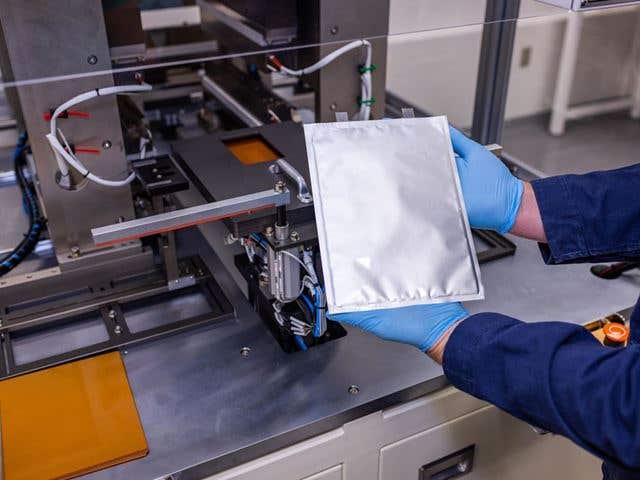Game-changing battery technology: Safer, non-flammable, and 10x more efficient than lithium
Discover how Alsym Energy’s nonflammable, water-based batteries are transforming renewable energy storage and decarbonizing industries globally.

Alsym’s inherently non-flammable batteries, made from readily available materials without lithium or cobalt, will be produced for EVs, stationary storage, and marine applications. (CREDIT: Alsym)
Lithium-ion batteries power a global shift toward cleaner energy. Yet, they pose significant limitations, especially in industrial and densely populated areas. Their flammability and toxicity make them unsuitable for large-scale energy storage in environments like city centers or industrial plants.
A breakthrough from Alsym Energy offers a safer, more sustainable alternative. Their new battery technology, developed with relatively abundant and stable materials, relies on a water-based electrolyte. The innovation is poised to fill critical gaps in renewable energy storage and industrial decarbonization.
A Safer, Sustainable Energy Solution
"Renewables are intermittent, so you need storage," explains Kripa Varanasi, an MIT professor and Alsym co-founder. "To truly solve the decarbonization problem, we need affordable batteries that can be made anywhere."
Unlike traditional lithium-ion batteries, Alsym's design is nonflammable and nontoxic, removing barriers to deployment in sensitive environments. Mukesh Chatter, Alsym's co-founder and CEO, highlights its transformative potential: "No chemical or steel plant would dare put a lithium battery on their premises. Industrial emissions are a much bigger problem than passenger cars, and this approach offers a new path."
The battery’s electrodes are primarily composed of manganese oxide and other metal oxides, while its water-based electrolyte eliminates fire risks. This chemistry enables batteries to be packed tightly, reducing size and cost without the need for heavy safety equipment. Existing lithium-ion manufacturing facilities can easily adapt to produce these batteries, further reducing operational costs.
Chatter’s journey toward revolutionizing battery technology began with a desire to address global energy inequities. After losing his mother to cancer in 2012, he sought to focus on technologies with the potential to improve the lives of at least a billion people. Access to electricity, he realized, was a critical need.
“When you don’t have electricity, you lose access to essentials like the internet, cell phones, and education,” Chatter explains. Determined to create an affordable and safe energy solution, he collaborated with experts including Varanasi, Rensselaer Polytechnic Institute professor Nikhil Koratkar, and researcher Rahul Mukherjee.
Related Stories
- Breakthrough graphene technology revolutionizes battery safety and performance
- Massive battery innovation could extend EV range to over 3,000 miles on a single charge
- EV battery breakthrough doubles range to over 700 miles per charge
Despite initial challenges in recruiting researchers, Chatter's determination led to the formation of Alsym Energy. By 2020, the team had finalized their innovative battery chemistry after exploring various alternatives.
Revolutionizing Energy Storage
The battery’s design addresses a range of needs. While its energy density is slightly lower than lithium-ion batteries, its adaptability shines. A 20-foot container of Alsym batteries stores 1.7 megawatt-hours of electricity and supports fast charging within four hours. It can also discharge power over durations ranging from two to 110 hours, making it suitable for diverse applications.
"We're highly configurable," Chatter notes. "This flexibility is critical for scenarios like running two solar cycles a day or combining solar and wind for continuous power."
Alsym’s technology supports renewable energy sources and caters to sectors previously underserved by conventional batteries. Industries such as chemical manufacturing, metal processing, and data centers now have safer, greener energy storage options. As artificial intelligence and digitalization expand, data centers face rising energy demands. Varanasi emphasizes the opportunity: "We must power the AI and digitization revolution without compromising our planet."
The company has also started field testing with customers worldwide. These tests include collaborations with municipalities, utilities, generator manufacturers, and providers of residential and commercial power. Discussions are underway with chemical and metal processing facilities to reduce their carbon footprint using Alsym’s storage solutions.
A Platform for Broader Innovation
Alsym's innovation isn’t confined to a single battery design. Varanasi describes the company as a "platform for energy storage," capable of supporting multiple chemistries for diverse applications. This flexibility reduces reliance on any single material, mitigating supply chain pressures.
"When you use a single material globally, you risk running out of it," Varanasi explains. "Our platform has already enabled us to develop three or four additional chemistries, each targeted at specific applications."
Alsym’s technology also tackles intermittent challenges faced by electrolyzers in green hydrogen production. By providing a reliable and sustainable storage solution, the company is contributing to global decarbonization efforts across industries.
Chatter's original goal—to bring electricity to a billion underserved people—remains central to Alsym’s mission. But the potential applications extend far beyond. With the ability to decarbonize industrial sectors, support renewable energy, and meet rising data center demands, Alsym’s batteries could drive profound global change.
“We started wanting to light up homes for a billion people,” Chatter reflects. “Now, we have a chance to impact the entire globe by cutting industrial emissions.”
Note: Materials provided above by The Brighter Side of News. Content may be edited for style and length.
Like these kind of feel good stories? Get The Brighter Side of News' newsletter.
Joshua Shavit
Science & Technology Writer | AI and Robotics Reporter
Joshua Shavit is a Los Angeles-based science and technology writer with a passion for exploring the breakthroughs shaping the future. As a contributor to The Brighter Side of News, he focuses on positive and transformative advancements in AI, technology, physics, engineering, robotics and space science. Joshua is currently working towards a Bachelor of Science in Business Administration at the University of California, Berkeley. He combines his academic background with a talent for storytelling, making complex scientific discoveries engaging and accessible. His work highlights the innovators behind the ideas, bringing readers closer to the people driving progress.



